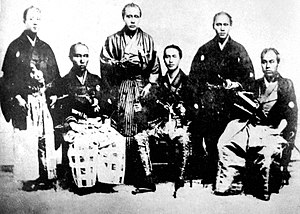I have been watching the NHK drama "
Atsuhime". Here in Los Angeles it is playing on a local cable channel. Before I had even heard of the show, I had been reading about the time period in Japanese history that the show covers.
The first episode was pretty cool because I kept saying to myself, "I know that character". I have read about the people portrayed in the show including Sakamoto Ryoma, Saigo Takamori, Katsu Kaishu, Tokugawa Yoshinobu and others. It seems to be a pretty amazing coincidence that this show is airing at the same time as I have been reading so much about this time period in Japanese history.
The show is pretty good but some of the characters do not live up to what I expect. They have been made to seem silly or a little goofy. I think this is common in these types of Japanese dramas. The actor portrays Sakamoto Ryoma in a fairly silly or goofy way. Even more so Saigo Takamori. The real Saigo was a man over 6 feet tall and with a strong but quiet or reserved personality. But the actor also portrays him in funny and silly way. And the actor is short. Not what I would expect from what I have read about Saigo, who was the inspiration for the movie "The Last Samurai."
However, I still like these Japanese historical dramas. Of course since I am interested in history, especially Japanese history, that is why they are interesting.
I also watched most of the year-long TV drama "
Shinsengumi" from several years ago. I think the characters and the story lines and the costumes are all really interesting. But, also with the Shinsengumi drama, the characters were certainly not portrayed very accurately in my opinion. It is pretty much a historical fact that Kondo Isami, the leader of the Shinsengumi, was a brutal man that was responsible for the violent and bloody deaths of many enemies of the Shogun. But the television show portrayed him as a friendly, ethical, honorable man. Certainly not based completely in reality. It is true that Kondo was very loyal to the Shogun. An honorable trait. But, of course, he displayed that loyalty with brutal violence.
I know Korean dramas have also been popular in Japan. I watched a Korean drama a couple of years ago that was also really popular in Japan. I really got into it. It was called "
Dae Jang Geum" or "Jewel in the Palace". I first saw it while visiting Japan for several weeks in 2006. But it was dubbed in Japanese. Even so it looked interesting.
What I did not like is that the show was dubbed in Japanese. I don't like dubbing. I prefer subtitles and I prefer to hear the actors real voice. You get a much better feeling of the character if you hear the actors actual voice rather then a dubbed voice.
I lucked out though. After returning to Los Angeles, the show started playing on an Asian cable channel with English subtitles. They were doing marathon weekend showings and I DVR'd it and watched the entire series. Great show.
(12/15/08) Note:
I believe the TV show made an error regarding the scene where Ryoma was killed. It showed Ryoma with his handgun. But according to the books I have read, Ryoma did not have it. He had given it to his sister. He was without his gun when he was attacked the second and final time where he died.









 Statue of Shinsengumi Commander Hijikata Toshizo
Statue of Shinsengumi Commander Hijikata Toshizo